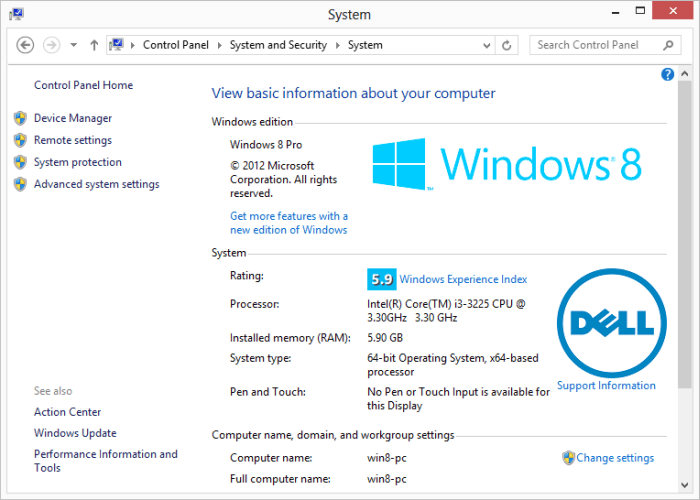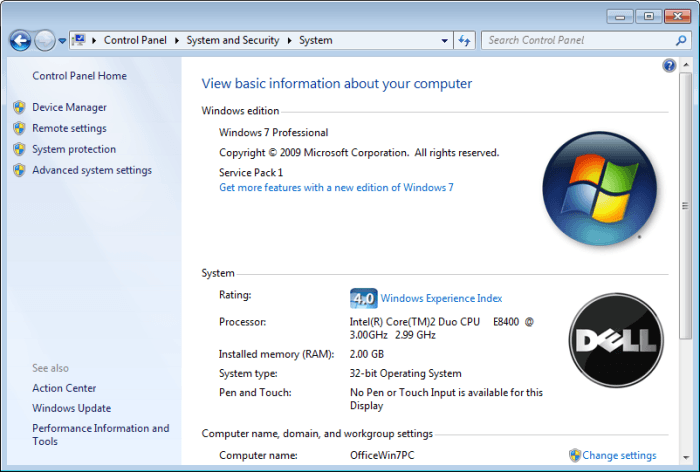Sometimes, installing software or device drivers has an adverse impact on your system. Setting a Restore Point prior to an installation allows you to reset your system to its previous state in case you discover that installing the new software wasn't such a good idea. (Restoring your system from a Restore Point is covered in the next tip.) Restore Points only deal with system files, so none of your personal data is affected.
To create a Restore Point, follow these steps if you are using Windows 8:
- Move the mouse pointer into the very bottom-left corner of the screen and right-click. You should see a Context menu appear.
- Choose the System option. Windows displays the System area of the Control Panel. (See Figure 1.)

Figure 1. The System dialog box.
- Click the System Protection link at the left of the dialog box. Windows displays the System Protection tab of the System Properties dialog box. (See Figure 2.)

Figure 2. The System Protection tab of the System Properties dialog box.
- Select the disk (under the Protection Settings group) for which you want to create a Restore Point
- Click the Create button. Windows displays the System Protection dialog box, prompting you to enter a description for the Restore Point.
- Enter a description of your choosing. (A good idea is to enter a reason for your restore point.
- Click Create. Windows creates the desired restore point.
If you are using Windows 7 the steps are a bit different. (The biggest difference is how you get to the first dialog box.). Follow these steps:
- Click Start, right-click Computer, and select Properties from the resulting Context menu. Windows displays the System area of the Control Panel. (See Figure 3.)

Figure 3. The System dialog box.
- Click the System Protection link at the left of the dialog box. Windows displays the System Protection tab of the System Properties dialog box. (See Figure 4.)

Figure 4. The System Protection tab of the System Properties dialog box.
- Select the disk (under the Protection Settings group) for which you want to create a Restore Point
- Click the Create button. Windows displays the System Protection dialog box, prompting you to enter a description for the Restore Point.
- Enter a description of your choosing. (A good idea is to enter a reason for your restore point.
- Click Create. Windows creates the desired restore point.

 This tip (12211) applies to Windows 7 and 8.
This tip (12211) applies to Windows 7 and 8.
Author Bio
Barry Dysert
Barry has been a computer professional for over 35 years, working in different positions such as technical team leader, project manager, and software developer. He is currently a software engineer with an emphasis on developing custom applications under Microsoft Windows. When not working with Windows or writing Tips, Barry is an amateur writer. His first non-fiction book is titled "A Chronological Commentary of Revelation." Learn more about Barry...
Removing a Place from the Recent Places or Quick Access Lists
Some Windows features can be both time savers and privacy concerns at the same time. The Recent Places list and the Quick ...
Discover More
Scheduling a Program to Run on a Schedule
If you have certain programs that you want to have run automatically, you can use Windows Task Scheduler to quickly set ...
Discover More
Using a Dvorak Keyboard with Windows
Dvorak keyboards can provide more efficient typing as well as make the keyboard characters more accessible to those who ...
Discover More
Should I Leave My Computer On All the Time?
Do you turn your computer on and off all the time? Do you really know if this is good for your computer or not?
Discover More
Starting Windows 10 in Safe Mode
Hopefully you'll never find yourself in a situation where you need to restart your computer in Safe Mode. If you do, ...
Discover More
Folder Size Limits
Windows 10 allows for items to be organized into folders and subfolders. What size restrictions does Windows 10 place on ...
Discover More




![]()
![]() This tip (12211) applies to Windows 7 and 8.
This tip (12211) applies to Windows 7 and 8.
Comments